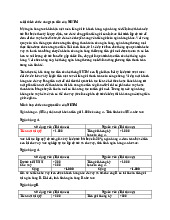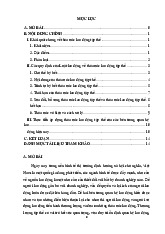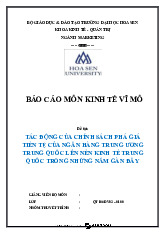







Preview text:
lOMoAR cPSD| 46578282
Name: Lương Hải Yến MSV: 11216372 Marco chapter 33 1. a. b.
When aggregate demand decreased there will be leftward shifting on the demand
curve, causing price level and quantity of output to decline. c.
Finally using the sticky wage theory short run aggregate supply would shift to the
right, eventually off setting the change in quantity of output because because workers re-
enter the workforce and agreed to lower wages when prices all lower 2.
b. The United auto workers union was an unexpectedly hi wave increase in its new contract
a. Immigrations-> labor force increase-> N increase -> PGDP increase
c. Intel invent new and more powerful computer chip. Technological advance increase ->
PGDP increase -> LAshift right
d. A severe hurricanes factories along the East Coast. Destruction of capital-. PGDP
decrease -> LAS shift left 3. a.
The initial equilibrium is labeled as point A. SRAS represent short run aggregate
supply and AD represent aggregate demand b.
When the central bank increased the money supply I will be told that aggregate
demand would shift rightward.
The new equilibrium is represented with point B on the graph. Output and price level will
both increase in the short run. c.
The long run equilibrium is represented with Point C. Price move up even more
and the quantity of output returns to its normal level. A left worship in the short run
aggregate supply curve is what causes this move from point B to C. this movement in SARS
can be attributed to wages perceptions and price will all adjust to the new price level. This
adjustment means the economy moves back to its “nature rate output” Marco Chapter 24
Ex 1. The theory of liquidity preference is Keynes's theory of how the interest rate is
determined. According to the theory, the aggregate-demand curve slopes downward
because: (1) a higher price level raises money demand; (2) higher money demand leads to a
higher interest rate; and (3) a higher interest rate reduces the quantity of goods and services
demanded. Thus, the price level has a negative relationship with the quantity of goods and services demanded. lOMoAR cPSD| 46578282
Ex 2. A decrease in the money supply shifts the money-supply curve to the left. The
equilibrium interest rate will rise. The higher interest rate reduces consumption and
investment, so aggregate demand falls. Thus, the aggregate-demand curve shifts to the left.
Ex 3. If the government spends $3 billion to buy police cars, aggregate demand might
increase by more than $3 billion because of the multiplier effect on aggregate demand.
Aggregate demand might increase by less than $3 billion because of the crowding-out effect on aggregate demand.
Ex 4. If pessimism sweeps the country, households reduce consumption spending and firms
reduce investment, so aggregate demand falls. If the Fed wants to stabilize aggregate
demand, it must increase the money supply, reducing the interest rate, which will induce
households to save less and spend more and will
encourage firms to invest more, both of which will
increase aggregate demand. If the Fed does not
increase the money supply, Congress could increase
government purchases or reduce taxes to increase aggregate demand.
Ex 5. Government policies that act as automatic
stabilizers include the tax system and government
spending through the unemployment-benefit system.
The tax system acts as an automatic stabilizer because
when incomes are high, people pay more in taxes, so
they cannot spend as much. When incomes are low, so
are taxes; thus, people can spend more. The result is
that spending is partly stabilized. Government spending through the unemployment-benefit Problems and Applications Ex 1, MS1 MS2
a. When the Fed’s bond traders buy bonds in open - market operations, the money-supply
curve shifts to the right from MS 1 to MS 2 Money Demand Quantity of Money
system acts as an automatic stabilizer because in recessions the government transfers money
to the unemployed so their incomes do not fall as much and thus their spending will not fall as much lOMoAR cPSD| 46578282
b. When an increase in credit card availability reduces the cash people hold, the
moneydemand curve shifts to the left from MD 1 to MD 2, as shown in Figure 2. The
result is a decline in the interest rate.
c. When the Federal Reserve reduces reserve requirements, the money supply increases,
so the money-supply curve shifts to the right from MS 1 to MS 2, as shown in Figure 1.
The result is a decline in the interest rate.
d. When households decide to hold more money to use for holiday shopping, the
moneydemand curve shifts to the right from MD 1 to MD 2, as shown in Figure . The
result is a rise in the interest rate.
e. When a wave of optimism boosts business investment and expands aggregate demand,
money demand increases from MD 1 to MD 2 in Figure . The increase in money
demand increases the interest rate. Ex 2
a. The increase in the money supply will cause the equilibrium interest rate to decline, as
shown in Figure . Households will increase spending and will invest in more new
housing. Firms too will increase investment spending. This will cause the aggregate
demand curve to shift to the right as shown in Figure .
b. As shown in Figure , the increase in aggregate demand will cause an increase in both
output and the price level in the short run.
c. When the economy makes the transition from its short-run equilibrium to its long-run
equilibrium, short-run aggregate supply will decline, causing the price level to rise even further.
d. The increase in the price level will cause an increase in the demand for money, raising
the equilibrium interest rate. lOMoAR cPSD| 46578282
e. Yes. While output initially rises because of the increase in aggregate demand, it will fall
once short-run aggregate supply declines. Thus, there is no long-run effect of the
increase in the money supply on real output. Ex 4
A tax cut that is permanent will have a bigger impact on consumer spending and aggregate
demand. If the tax cut is permanent, consumers will view it as adding substantially to their
financial resources, and they will increase their spending substantially. If the tax cut is
temporary, consumers will view it as adding just a little to their financial resources, so they
will not increase spending as much.
Ex 5. a. The current situation is shown in Figure b.
The Fed will want to stimulate aggregate demand. Thus, it will need to lower the
interest rate by increasing the money supply. This could be achieved if the Fed purchases
government bonds from the public. lOMoAR cPSD| 46578282 c.
As shown in Figure 8, the Fed's purchase of government bonds shifts the supply of
money to the right, lowering the interest rate. d. The Fed's purchase of government bonds
will increase aggregate demand as consumers and firms respond to lower interest rates.
Output and the price level will rise as shown in Figure 9.. Ex 6.
a. Legislation allowing banks to pay interest on checking deposits increases the return to
money relative to other financial assets, thus increasing money demand.
b. If the money supply remained constant (at MS1), the increase in the demand for
money would have raised the interest rate, as shown in Figure . The rise in the interest
rate would have reduced consumption and investment, thus reducing aggregate
demand and output. This edition is intended for use outside of the U.S. only, with lOMoAR cPSD| 46578282
content that may be different from the U.S. Edition. This may not be resold, copied, or
distributed without the prior consent of the publisher.
c. To maintain a constant interest rate, the Fed would need to increase the money supply
from MS 1 to MS 2. Then aggregate demand and output would be unaffected. Ex 7.
a. If there is no crowding out, then the multiplier equals 1/(1 – MPC ). Because the
multiplier is 3, then MPC = 2/3.
b. If there is crowding out, then the MPC would be larger than 2/3. An MPC that is
larger than 2/3 would lead to a larger multiplier than which is then reduced down to 3 by the crowding-out effect. Ex 8
a. The initial effect of the tax reduction of $20 billion is to increase aggregate demand
by $20 billion x 3/4 (the MPC ) = $15 billion.
b. Additional effects follow this initial effect as the added incomes are spent. The
second round leads to increased consumption spending of $15 billion x 3/4 = $11.25
billion. The third round gives an increase in consumption of $11.25 billion x 3/4 = $8.44
billion. The effects continue indefinitely. Adding them all up gives a total effect that
depends on the multiplier. With an MPC of 3/4, the multiplier is 1/(1 – 3/4) = 4. So the
total effect is $15 billion x 4 = $60 billion.
c. Government purchases have an initial effect of the full $20 billion, because they
increase aggregate demand directly by that amount. The total effect of an increase in
government purchases is thus $20 billion x 4 = $80 billion. So government purchases
lead to a bigger effect on output than a tax cut does. The difference arises because
government purchases affect aggregate demand by the full amount, but a tax cut is lOMoAR cPSD| 46578282
partly saved by consumers, and therefore does not lead to as much of an increase in aggregate demand.
d. The government could increase taxes by the same amount it increases its purchases. Ex 9.
a. If the marginal propensity to consume is 0.8, the spending multiplier will be
1/(10.8) = 5. Therefore, the government would have to increase spending by
$400/5 = $80 billion to close the recessionary gap.
b. With an MPC of 0.8, the tax multiplier is (0.8)(1/(1-0.8)) = (0.8)(5) = 4. Therefore,
the government would need to cut taxes by $400 billion/4 = $100 billion to close the recessionary gap.
c. If the central bank was to hold the money supply constant, my answer would be
larger because crowding out would occur.
d. They would have to raise both government spending and taxes by $400 billion. The
increase in government purchases would result in a boost of $2,000 billion, while
the higher taxes would reduce spending by $1,600 billion. This leaves a $400 billion rise in aggregate spending.
Ex 9A. If government spending increases, aggregate demand rises, so money demand
rises. The increase in money demand leads to a rise in the interest rate and thus a
decline in aggregate demand if the Fed does not respond. But if the Fed maintains a
fixed interest rate, it will increase money supply, so aggregate demand will not decline.
Thus, the effect on aggregate demand from an increase in government spending will be
larger if the Fed maintains a fixed interest rate. Ex 10.
a. Expansionary fiscal policy is more likely to lead to a short-run increase in investment
if the investment accelerator is large. A large investment accelerator means that the
increase in output caused by expansionary fiscal policy will induce a large increase in
investment. Without a large accelerator, investment might decline because the
increase in aggregate demand will raise the interest rate.
b. Expansionary fiscal policy is more likely to lead to a short-run increase in investment
if the interest sensitivity of investment is small. Because fiscal policy increases
aggregate demand, thus increasing money demand and the interest rate, the greater
the sensitivity of investment to the interest rate the greater the decline in investment
will be, which will offset the positive accelerator effect. Ex12.
a. Tax revenue declines when the economy goes into a recession because taxes are
closely related to economic activity. In a recession, people's incomes and wages fall, as
do firms' profits, so taxes on these things decline.
b. Government spending rises when the economy goes into a recession because more
people get unemployment-insurance benefits, welfare benefits, and other forms of income support. lOMoAR cPSD| 46578282
c. If the government were to operate under a strict balanced-budget rule, it would
have to raise tax rates or cut government spending in a recession. Both would reduce
aggregate demand, making the recession more severe. Ex 13.
a. If there were a contraction in aggregate demand, the Fed would need to increase
the money supply to increase aggregate demand and stabilize the price level, as
shown in Figure . By increasing the money supply, the Fed is able to shift the
aggregatedemand curve back to AD 1 from AD 2. This policy stabilizes output and the price level.
b. . If there were an adverse shift in short-run aggregate supply, the Fed would need
to decrease the money supply to stabilize the price level, shifting the
aggregatedemand curve to the left from AD 1 to AD 2, as shown in Figure 12. This
worsens the recession caused by the shift in aggregate supply. To stabilize output,
the Fed would need to increase the money supply, shifting the aggregate-demand
curve from AD 1 to AD 3. However, this action would raise the price level.




